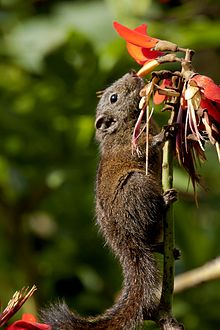Nilgiri striped squirrel
| Nilgiri striped squirrel | |
|---|---|

| |
| Scientific classification | |
| Kingdom: | |
| Phylum: | |
| Class: | |
| Order: | |
| Family: | |
| Genus: | |
| Subgenus: | |
| Species: | F. sublineatus
|
| Binomial name | |
| Funambulus sublineatus (Waterhouse, 1838)
| |
| Synonyms | |
|
Funambulus kathleenae Thomas & Wroughton, 1915 | |
The Nilgiri palm squirrel (Funambulus sublineatus) is the Indian form (formerly subspecies F. s. sublineatus) of squirrels collectively known as Dusky-palm squirrels. It is a species of rodent in the Sciuridae family.
Taxonomy
The species known in the past has recently been split into two species. The Indian form (formerly subspecies F. s. sublineatus) has now been referred to as the Nilgiri palm squirrel, whereas the Sri Lankan form (formerly F. s. obscurus) may now be referred to as the dusky palm squirrel.[2]
The systematics of the dusky striped squirrel, are reassessed against new evidence following a revision of its genus, Funambulus. Mitochondrial DNA suggests that the Sri Lankan subspecies of F. sublineatus is the sister taxon of Funambulus layardi. Despite its phenotypic similarity to the nominate species, morphological and mtDNA evidence is presented for these species plus additional mtDNA data from Funambulus palmarum and Funambulus pennantii. Morphometric data indicate that the two taxa conventionally considered subspecies of F. sublineatus are sufficiently distinct for them to be ranked separately, resulting in two further endemic mammal species in India and Sri Lanka and an increase in Funambulus diversity. The name of the Sri Lankan species changes to Funambulus obscurus. Whether the mtDNA phylogeny is a true reflection of F. obscurus and F. layardi remains unresolved.[3]
Distribution
The former range of the species, before the taxonomic split[3] was in both India and Sri Lanka, though the Nilgiri palm squirrel (F. sublineatus) is now restricted in distribution to the Western Ghats of India. Very little is known of this squirrel, probably the smallest in the genus weighing about 40g. Its new status as an endemic mammal to India means records need updating.
The species is confined to wet humid forests either in the Western Ghats and Nilgiri hills (and surrounding areas such as around Kodaikanal in India)
References
- ^ Template:IUCN2008
- ^ Rajith Dissanayake. 2012. The Nilgiri striped squirrel (Funambulus sublineatus), and the dusky striped squirrel (Funambulus obscurus), two additions to the endemic mammal fauna of India and Sri Lanka. Small Mammal Mail. Vol 3(2):6-7
- ^ a b Dissanayake, Rajith; Oshida, Tatsuo (2012). "The systematics of the dusky striped squirrel, Funambulus sublineatus (Waterhouse, 1838) (Rodentia: Sciuridae) and its relationships to Layard's squirrel, Funambulus layardi Blyth, 1849". Journal of Natural History. 46 (1–2): 91–116. doi:10.1080/00222933.2011.626126.

